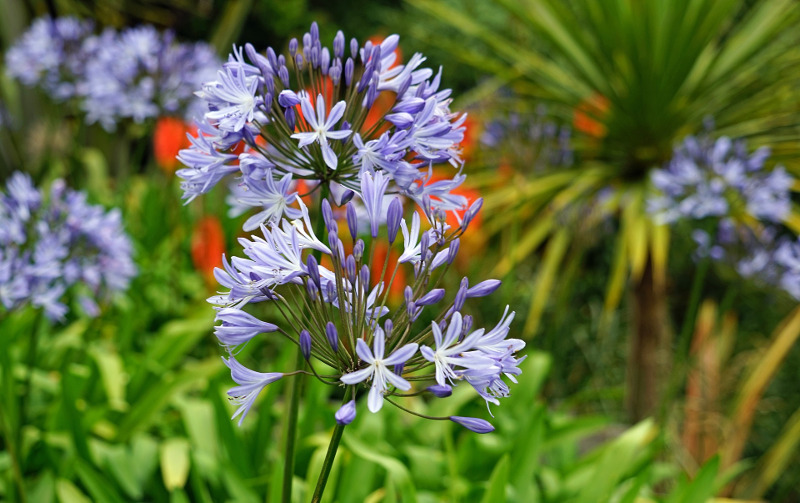Spectacular Agapanthus: Enhancing Your Yard's Beauty
Spectacular Agapanthus: Enhancing Your Yard's Beauty
Blog Article
Letting Loose the Secret to Effective Agapanthus Farming: Idea for a Flourishing Garden
In the world of gardening, growing agapanthus effectively requires a strategic strategy that includes various facets of plant treatment. By comprehending the subtleties of agapanthus cultivation, one can develop an atmosphere where these plants flourish and grow generously.
Planting Agapanthus: Ideal Practices
When growing Agapanthus, appropriate soil prep work is vital for making certain effective development and advancement of these stunning flowers. Agapanthus, generally understood as Lily of the Nile or African lily, thrives in well-draining dirt with a slightly acidic to neutral pH degree - Agapanthus. Before growing, it is important to amend hefty clay dirts with raw material such as compost or peat moss to boost drainage and give vital nutrients for the plants
To grow Agapanthus, choose an area that receives complete sunlight to partial shade, as this will certainly promote healthy and balanced growth and plentiful blooming. Dig an opening two times the size of the plant's root sphere and position the Agapanthus at the exact same deepness it was previously growing. Delicately backfill the hole with soil, pushing down strongly to remove any type of air pockets around the origins.
Water the newly planted Agapanthus extensively and continue to maintain the dirt evenly damp, specifically during the plant's active growing period. Agapanthus. Applying a balanced plant food once a month can better support the plant's growth and flowering. By complying with these finest practices for growing Agapanthus, you can develop a sensational display screen of these captivating flowers in your yard
Perfect Dirt Conditions for Agapanthus
For optimal growth and flowering success of Agapanthus plants, making sure the soil conditions are perfect is essential. Agapanthus prefers dirt that is rich in nutrients, so integrating a balanced fertilizer during the expanding period can promote healthy development and dynamic blossoms.

Watering and Feeding Tips
To ensure healthy development and vivid blossoms, correct watering and feeding methods are crucial for successful Agapanthus farming. Agapanthus plants profit from routine watering, particularly during the expanding period.
When it involves feeding Agapanthus, a well balanced fertilizer with equal components nitrogen, phosphorus, and potassium can be applied in the spring to advertise healthy and balanced development and blooming. Slow-release fertilizers are perfect for offering nutrients progressively over an extensive period. Stay clear of over-fertilizing, as this can lead to too much vegetation growth at the expenditure of blossoms.
In addition, incorporating raw material like compost into the soil can improve nutrient degrees and improve soil structure, aiding in the general health and wellness of the Agapanthus plants. By complying with these watering and feeding suggestions, gardeners can guarantee their Agapanthus plants flourish and produce magnificent displays of flowers.
Trimming and Deadheading Methods
Proper trimming and deadheading strategies play a crucial duty in preserving the wellness and check this aesthetic appeals of Agapanthus plants, enhancing the crucial methods of watering and feeding for effective cultivation. Pruning Agapanthus involves getting rid of spent flower heads, dead or yellowing leaves, and total shaping of the plant to advertise much better growth. Deadheading, the process of getting rid of discolored flowers, not just enhances the plant's look yet additionally motivates more growing.
When deadheading Agapanthus, it is advisable to clip off the blossom stem at the base using sharp, clean shears. This process reroutes the plant's power from seed manufacturing back into root and vegetation growth, advertising a healthier and more durable plant. Regular deadheading can prolong the growing period of Agapanthus and prevent self-seeding, which can cause overcrowding.
In regards to pruning, Agapanthus typically take advantage of a light trim after blossoming to clean the plant and urge fresh development. Reducing back the invested flower stems and eliminating any kind of dead or broken vegetation assists preserve the plant's vigor and overall appearance. Nevertheless, it is vital to stay clear of reducing right into the crown of the plant, as this can deteriorate its health and wellness.

Protecting Agapanthus From Pests and Diseases
Executing efficient insect and disease monitoring approaches is vital to securing the health and vigor of Agapanthus plants in farming. Agapanthus are usually sturdy plants, however they can still fall victim to numerous insects and diseases otherwise properly looked after. One typical insect that influences Agapanthus is the Agapanthus borer, a caterpillar that tunnels into the plant, triggering damage to the fallen leaves and blossoms. To avoid infestations, normal check out this site examination of the plants is important. If borers are discovered, they can be manually removed, or insecticidal soap can be utilized as a control look at this website measure.
In addition to insects, Agapanthus are prone to illness such as root rot and fungal leaf spots. By staying vigilant and resolving bug and condition issues quickly, gardeners can help their Agapanthus grow and thrive.

Conclusion
Finally, successful growing of agapanthus calls for proper growing strategies, suitable dirt conditions, appropriate watering and feeding, regular trimming and deadheading, and defense from conditions and pests. By complying with these methods and tips, gardeners can make certain a flourishing garden loaded with beautiful agapanthus flowers. Agapanthus. Keep in mind to keep regular treatment and interest to detail to advertise the wellness and longevity of these stunning plants
When growing Agapanthus, correct dirt prep work is important for making sure effective development and growth of these attractive flowers.Water the newly planted Agapanthus completely and continue to keep the soil uniformly damp, particularly throughout the plant's energetic expanding season.For ideal growth and flowering success of Agapanthus plants, making sure the dirt problems are suitable is critical. When transplanting or planting Agapanthus, guarantee the soil is well-prepared to provide the necessary foundation for the plants to develop themselves efficiently. One usual bug that impacts Agapanthus is the Agapanthus borer, a caterpillar that tunnels right into the plant, triggering damage to the blossoms and leaves.
Report this page